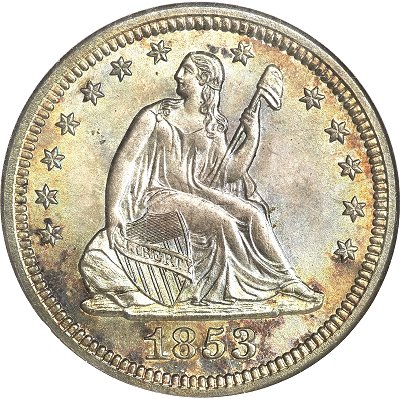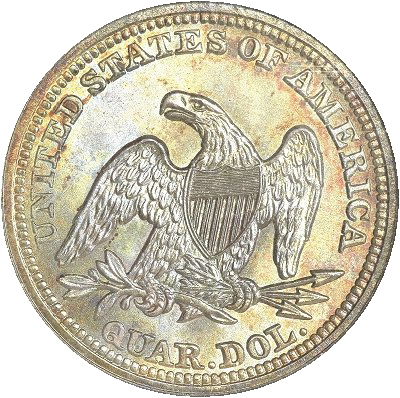

|
|
|
1853 No Arrows Liberty Seated Quarter Dollar
by Greg Johnson
The bimetallic standard enacted in 1834 fixed the
relative values of silver and gold at a ratio of 16.002 to 1. This was later
adjusted to 15.988 to 1 in 1837. This bimetallic standard worked effectively
until 1844 when the relative price of gold fell with respect to silver, resulting
in silver exports to England exceeding imports from Mexico. The ratio continued
to decrease gradually until the gold rush in 1848, which accelerated the decrease
in the ratio until full weight United States silver coins no longer circulated
at all. Early in 1851 the market ratio fell to 15.45 to 1. The one dollar gold
coin, authorized in 1849, effectively took the place of silver half dollars
and quarters in circulation and further hastened the disappearance of silver
from circulation.
Though a crisis was developing and the silver currency of the country was dwindling
away, Congress was split and indecisive regarding just how to structure the
US monetary system. While Congress debated and finally enacted a bill authorizing
the 3 cent silver coin, the difference between silver exports and imports jumped
from $2,000,000 in 1850 to $23,000,000 in 1851. During those two years the amount
of silver exported exceeded the total volume coined by the United States mint
during the preceding twenty years.1
“Before the end of 1851 conditions in retail
trade had become chaotic. Trade was carried on with gold dollars, 3 cent pieces,
underweight dimes and half-dimes, and badly worn Spanish reals and medios (half
reals). The gold dollars were too small in size and too large in value. The
dimes and half-dimes were the few survivors of the systematic culling out of
good weight coins. The Spanish fractions were a motley collection of underweight
coins. The adverse ratio had long since stopped the importation of Spanish coins
of good condition, but badly worn pieces were still brought in…the whole
world was ransacked for Spanish coins that had been discarded as unfit for circulation.”1 Back
to Quarter of Month Topic List 

After two years of delays and wrangling in Congress, involving several different
proposals, much debate, and many amendments, a bill reducing the weight of the
silver half dollar, quarter, dime and half dime was signed into law by the President
on February 21, 1853. The complexity of both the bill itself, and the issues
it attempted to address, are underscored by a member of congress who stated
that he could not understand it and would therefore vote against it.1 A detailed
accounting of the issues and progress of the bill through Congress is provided
by Carothers in Chapter 9 of his book Fractional Money.(1)
Prior to the implementation of the weight reductions, the United States mints
produced a number of “old weight” coins dated 1853. These include
half dimes at both the Philadelphia and New Orleans mints, dimes and quarters
in Philadelphia, and a very few half dollars in New Orleans. These so-called
“no arrows” coins are popular with collectors today. The 1853 no
arrows quarter is a well known rarity (PCGS Coin #5421) in the liberty seated
quarter series. The variety was recognized as early as 1867, at which time it
was catalogued by W. Elliot Woodward in the Mickley sale. During 2008 the LSCC
membership voted it number 8 on the list of greatest Philadelphia seated coins.
Attributionof the 1853 no arrows quarter is quite simple as the absence of arrows
and rays is obvious. Authentication, however, is necessary as, due to its high
value, attempts have been made to pass altered 1858 quarters as 1853 no arrows.
Spotting this alteration is straightforward as the date styles of the two issues
are notably different; specifically, the 1853 has a slanted upright in the “5”
and the 1858 does not. The 1853 No Arrows was the least reported of the Philadelphia
mint issues in the 1993 LSCC survey with a total of 12 examples. That number
increased to 20 in 2007. The grade profile of the 1853 No Arrows is very unusual
for a seated coin. Due to the hoarding and exporting described above there may
be more uncirculated examples than VF’s. Ten of the 20 pieces reported
in the 2007 survey were in AU or MS grades.
Reference (1): Fractional Money: A History of the Small Coins and Fractional
Paper Currency of the United States. Neil Carothers (1930). John Wiley and Sons,
Inc.
Images Courtesy of Heritage Archive